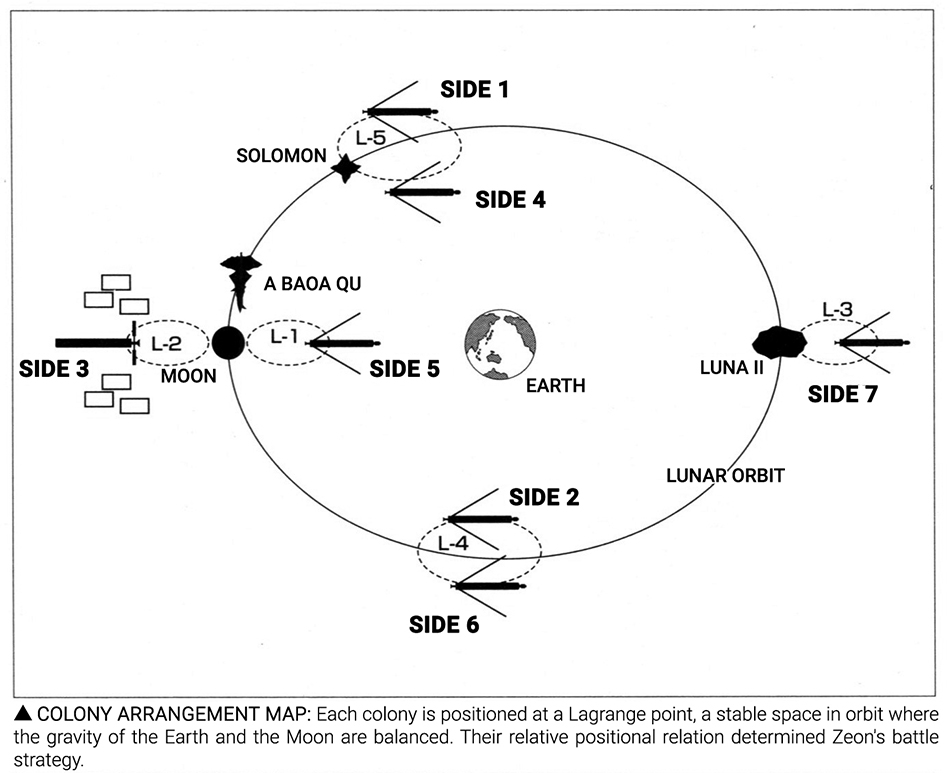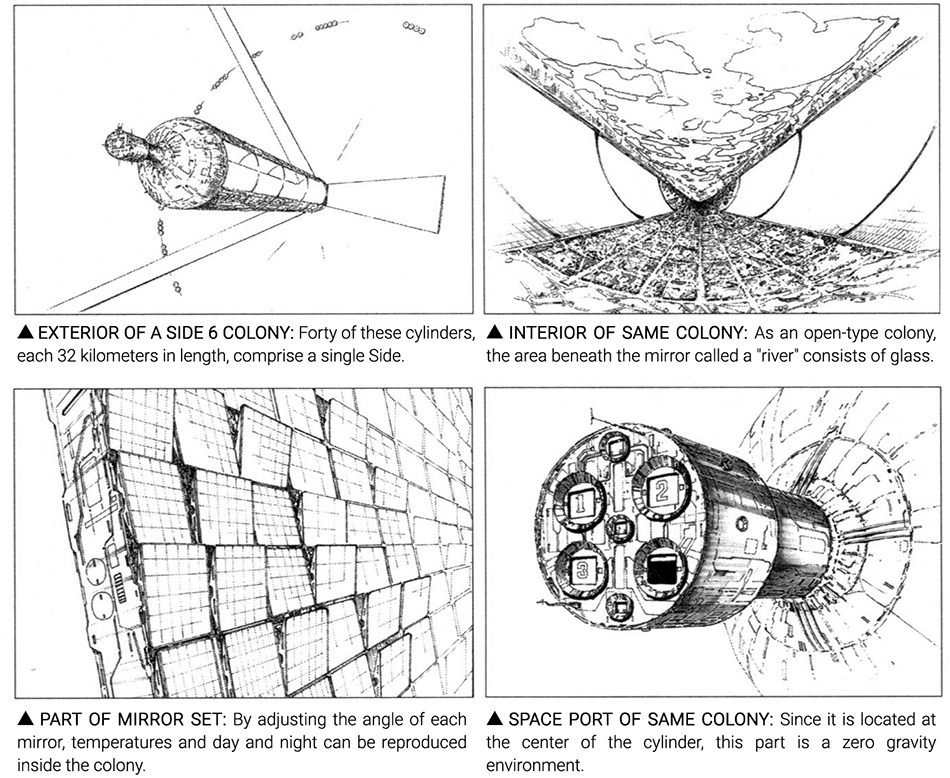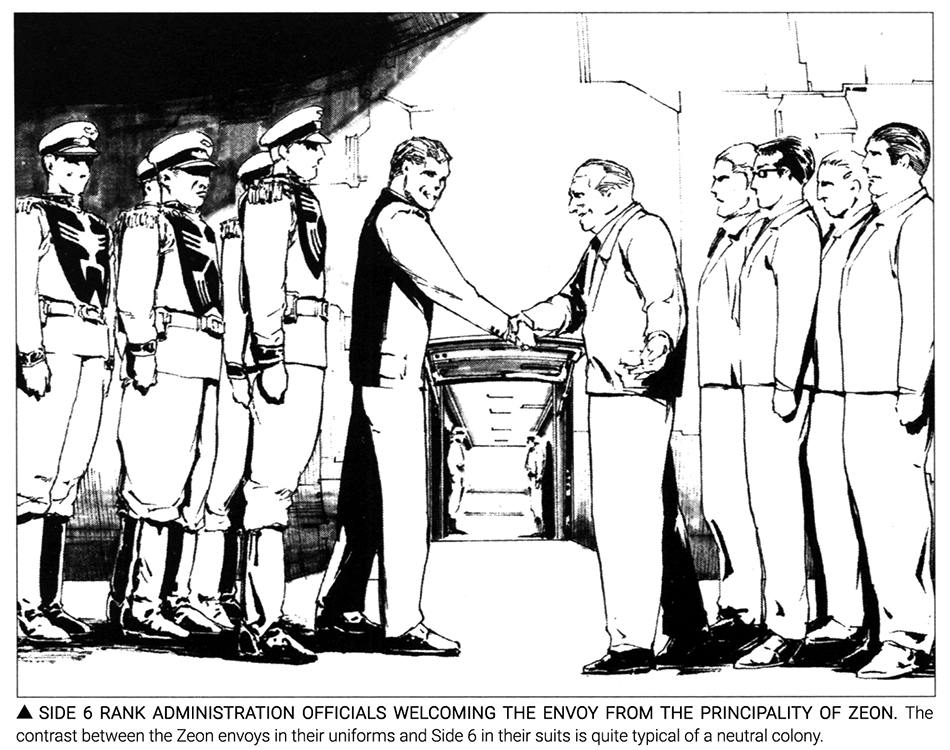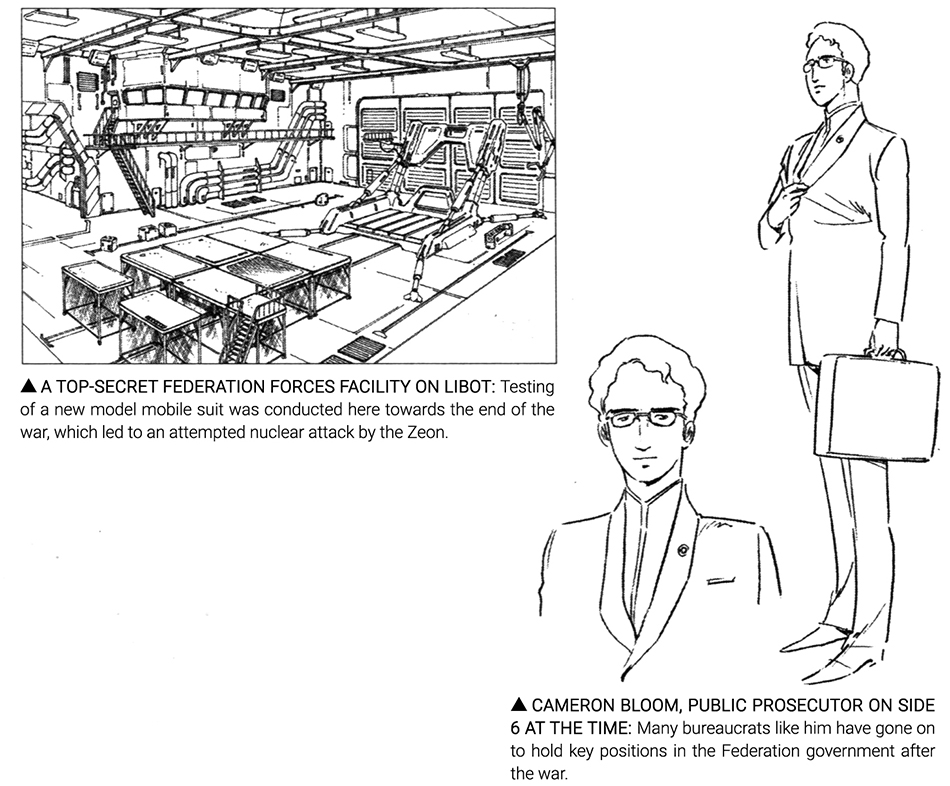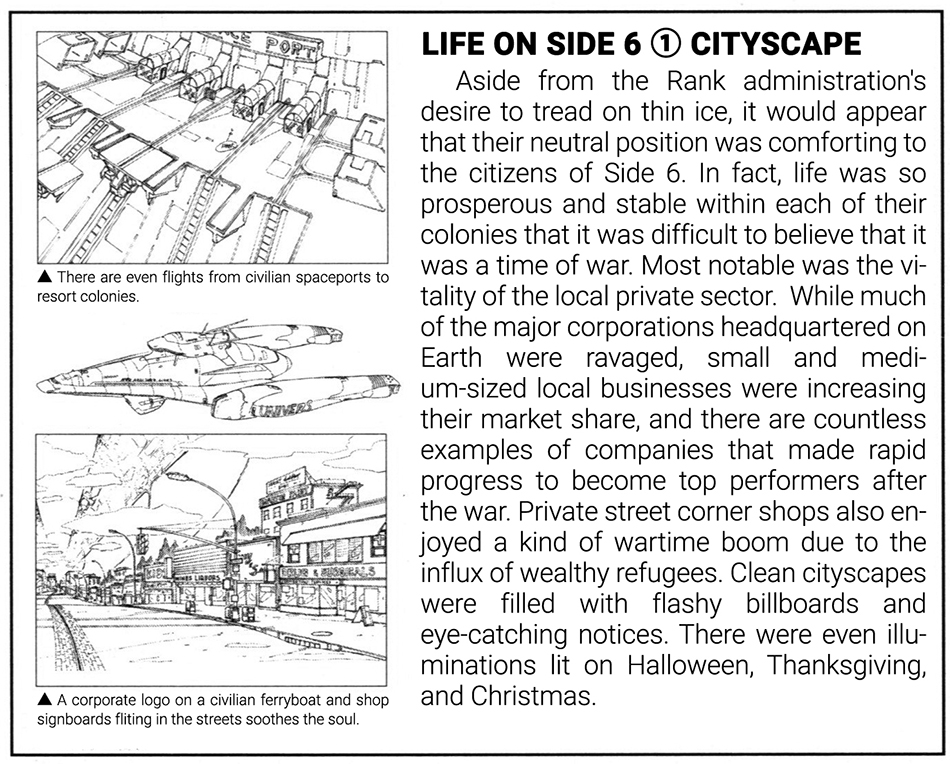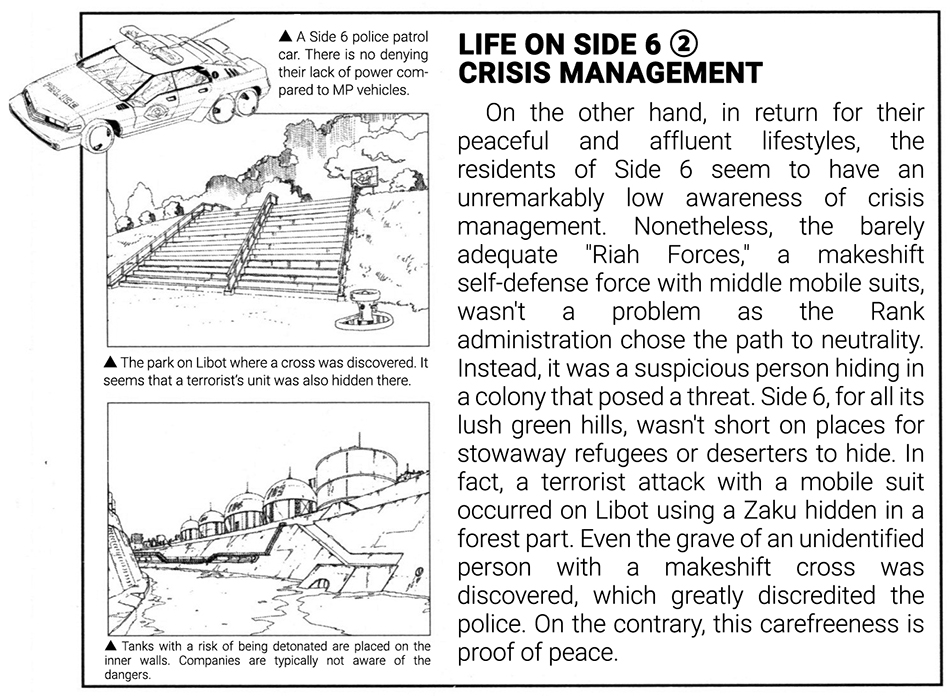GUNDAM OFFICIAL REPORT.4
GUNDAM OFFICIAL REPORT.4
THE REALITIES OF SIDE 6
What is the backdrop that gave rise to the neutral colonies?
GEOGRAPHY OF THE SIDES
The One Year War brought on an unprecedented disaster that caused the death of half of humanity. However, only one cluster of colonies in the middle of the throws of war remained neutral and suffered very little damage: Side 6, also known as Riah. Needless to say, though, this was an extremely unusual situation, mainly because the Principality of Zeon, while advocating for the independence and sovereignty of Spacenoids, mercilessly targeted the inhabitants of the colonies. During the One Week War, they launched surprise attacks on Sides 1, 2, and 4 with nuclear, biological, and chemical weapons. The Battle of Loum that followed ravaged Side 5, and the total loss to human life amounted to five billion.
So why was it that Side 6 was the only group that escaped the attack and could assume a neutral position? As far as the One Week War is concerned, it is all thanks to the Rank administration.
At the time of the One Year War, each colony had already acquired the autonomy to be considered a “nation” or a “state.” Not even the Earth Federation government could centrally manage the clusters of colonies that held 90% of the total population. Although still dominant in diplomacy and economics, they were close to being left to their own devices in terms of domestic affairs. In fact, Side 3’s stance of a “war for independence” was only a justification for declaring war, so it should have been possible for other Sides to declare their neutrality if the situation allowed it, though whether they could get approval or not was questionable.
Unfortunately, however, the Principality of Zeon did not have the luxury of waiting to see how other Sides would react. For the Zeon, already at a hopeless disadvantage in terms of national resources, obtaining immediate space superiority was their lifeline. In order to do so, Side 1 and 4, close to Zeon’s homeland, were chosen as targets of a surprise attack. At the same time, Side 2 was targeted to protect their rear line and drop the colony for Operation British. Side 6, located at L4 like Side 2, was excluded from their surprise attacks because the Principality of Zeon had propped up the Rank government.
This slight difference gave Side 6 the necessary time to lay the foundation for a declaration of neutrality.
THE NEED FOR A NEUTRAL ZONE
Zeon’s arrangements spared Side 6 from the ravages of the One Week War, but mayor Rank at the time was not so inefficient as to waste the time he was afforded. He immediately dispatched envoys to both forces after the war started and quickly obtained their informal consent through backwater lobbying. He declared neutrality to all of outer space on January 11th, U.C.0079, the day the One Week War came to a close.
This was, of course, an unusual condition, one that had no past precedent. Aside from Side 3, which had advocated independence in the first place, it was a flagrant act of abusing their authority for Side 6, a member of the Earth Federation, to declare its own neutrality, even though they were a de facto state. Despite this, the Federation’s ulterior motives played a significant role in framing the tacit approval of this declaration.
Before the opening of hostilities, the Federation camp had little doubt that it would be able to achieve a quick and overwhelming victory. Still, that prospect was completely upended in the span of just one week. In fact, among some of the military top brass at the time, some of the high-ranking officials were fearful of the ferocity shown by the mobile suits, and it is said that there was even support for a reluctant “surrender is unavoidable.” Also, for the Federation camp, the existence of a neutral zone as a diplomatic window of sorts was exactly what they wanted, so they gained far more from that than from denouncing any kind of overreach. The Zeon, of course, was left with little choice but to bet on their “insurance.”
This neutral zone, however, couldn’t just be anywhere. Aside from the Earth, Side 5 (Loum), located in a straight line between the Earth and Side 3, could be used as a shield by the Federation Forces, so it was a crucial target for the Zeon Forces to attack. Side 7 was also a front for Operation V for the Federation Forces, but it was mainly unfinished, so it could hardly be called a state. So, the only option remaining was Side 6, which held relatively little strategic value for either side.
Mayor Rank’s decision to shift towards neutrality was conscience-driven based on a clear understanding of the situation at hand and his own position. His quick response was also successful, and both parties’ forces approved of the declaration of neutrality with unprecedented expediency. Side 6, both in name and reality, broke free from Federation control, and Mayor Rank became Prime Minister. Yet, following the Battle of Loum, the Antarctic Treaty that was signed on January 31st prohibited the use of nuclear, biological, and chemical weaponry and colony drops, as well as prohibiting attacks on helium convoys from Jupiter, permanent settlements on the moon, and the “neutral zone.” Side 6 was, for the time being, able to remain in existence.
As mentioned previously, behind this series of political maneuverings, Side 5 was annihilated in the Battle of Loum on January 15th. Putting aside their geographical run of bad luck, the fate of Side 5 could have been changed if the administration at the time had quickly hoisted a pro-Zeon policy following the One Week War. But, on the other hand, if Side 6 had acted in self-interest, the Zeon would not have overlooked it, nor would the Federation have accepted the declaration of neutrality after the stalemate. Their foresight and political skill only separated the contrast of the two.
THE TRIUMPH OF OPPORTUNIST POLITICS
Although Side 6 declared their neutrality, it’s premature to assume that this guaranteed their safety. To start, a position of “not being hostile to either side” means, if you look at it from the other side, “not taking either side.” If we look back on postwar politics, we’re forced to walk a delicate tightrope of power. As for the Rank administration, its stance in the early stages of the war was unequivocally “pro-Zeon.”
Some attribute the sympathy the residents of Side 6 had towards Side 3 as the primary factor in this, but this would be irrational considering the fact that billions of colony inhabitants had already been sacrificed, even though many Spacenoids harbored bitter sentiments towards the Federation’s Earth supremacy and Rank himself had expressed his devotion to Zeon Deikun’s ideology of Contolism. If anything, the mere fact that the Zeon were the only side with the space force to destroy his own country is far more convincing. With regards to this, the craftiness of Rank, who had used his devotion to Contolism as a means to support pro-Principality, should be the focus.
In fact, when the tides of war began to tip in favor of the Federation in the later stages of the war, the Rank administration underwent drastic changes. Up to that point, Side 6 had been able to survive thanks to the Zeon “overlooking” them and had made every effort to accommodate requests from both forces’ naval vessels for docking, though following Operation Odessa, they refused to do so, shielding themselves with neutrality during wartime, though it was in name and not reality. But then, civilian facilities were relinquished to Federation Forces vessels, citing “humanitarian reasons” each time, and top-secret military facilities were even allowed to be constructed on some colonies. Naturally, there was a vehement backlash by the Zeon. Following the televised broadcast of the battle between the Federation Forces 13th Autonomous Squadron and the Zeon Forces Conscon Fleet in a nearby sector of space, the rebuke of Side 6’s neutrality was unilaterally announced, though there were no remaining forces to mount an attack.
It was only on December 25th that a nuclear attack on Libot was attempted based on the sole discretion of an officer. However, it was thwarted by the Federation Forces stationed there, which in effect forced them to withdraw from Side 6. Having given up on a Zeon “driven to ruin” and now working behind the scenes with the Federation Forces to find just the right moment to issue a statement against the Zeon clearly illustrates the astute calculations of the Rank administration.
Despite what was outlined above, it’s not surprising that Side 6 was a major player in concluding a ceasefire agreement. Shortly after the launch of Operation Star One, Rank made contact with Prime Minister Darcia, a member Zeon’s moderate faction, and was since then making every effort as a conduit to the Federation government. Not only did he provide a forum for secret talks, but he was also instrumental through his lobbying, becoming a central figure in ending the war. It’s well known just how much Side 6’s vocal influence had grown since the end of the war, having curried favor with both forces in this process.
In that sense, if there was any winner in the One Year War, it may well have been Side 6. Yet this victory was won without firing a single shot, just with exceptional politics.



